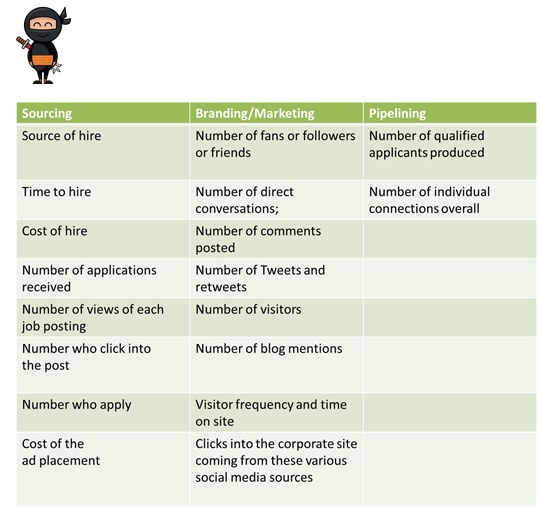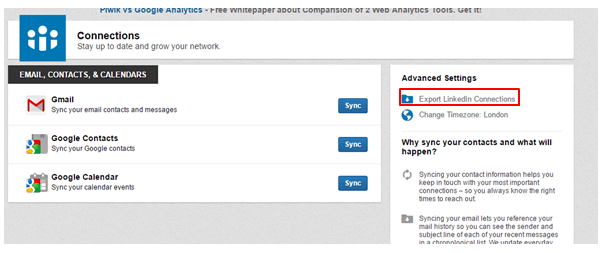Keep up with the latest hiring trends!
 Social has taken the recruitment world by storm. It has now become a core component of the marketing strategies for many recruiters, HR professionals and talent acquisition managers. What has accelerated this even more is the ubiquity of mobile which has been incorporated into our daily lives, enabling us to get instant access to social networking sites. This represents a major opportunity for employers to attract potential candidates for open job positions. According to a survey from Jobvite, social recruiting can result in a 44% increase in candidate quality and 34% increase in improved time to hire. Despite this, digital marketing agency encendo found that there is still a lack of investment from companies today in social recruiting, with one of the main barriers cited as being the inability to measure the return on investment.
Social has taken the recruitment world by storm. It has now become a core component of the marketing strategies for many recruiters, HR professionals and talent acquisition managers. What has accelerated this even more is the ubiquity of mobile which has been incorporated into our daily lives, enabling us to get instant access to social networking sites. This represents a major opportunity for employers to attract potential candidates for open job positions. According to a survey from Jobvite, social recruiting can result in a 44% increase in candidate quality and 34% increase in improved time to hire. Despite this, digital marketing agency encendo found that there is still a lack of investment from companies today in social recruiting, with one of the main barriers cited as being the inability to measure the return on investment.
According to Andy Headworth, this actually stems from the inability of many companies to measure their existing recruiting methods such as job boards, recruitment agencies, recruitment advertising etc. When dealing with recruiters, Andy says: “They have an idea of what they believe to be the most effective channels, but have no data to back it up. Ultimately they have absolutely no idea what their existing ROI is, so how are they going to credibly predict an ROI for using social media in their recruitment strategy?”.
This is the Catch22: many recruiters are unable to articulate any sort of ROI when it comes to social recruitment, yet one of the strengths of social recruitment (given that we now live in the era of Big Data) is the ability to measure your bang-for-your-buck and the transparent view it can provide of what activities are positively affecting your business. What really exacerbates this is the different levels of understanding sections of a company can have. While community managers, social media managers and recruiters typically focus on engagement data like clicks, likes and shares, recruitment leaders and internal stakeholders focus on social media analytics like reach, response metrics and traffic to the website. The CEO is concerned with business metrics such as the reputation of the brand, net promoter score and cost.
So how can you get out of this Catch22? What are the steps you need to take clearly define the ROI of your social media recruitment activities? What can you do to get the hard numbers required by your CEO? The bad news is that there is no one definitive method to calculate the return on investment in social recruiting costs. The good news however, is that recruiters can define their own ROI by tying social media initiatives to corporate objectives and goals, and therefore begin to target highly desirable candidates. In order to establish what social ROI looks like, you need to do the following things:
Define What Return Looks Like
Without defining what your return is from social media, you have nothing to measure success or failure against so this should be made clear and absolutely aligned with business objectives from the beginning. You are essentially asking yourself ‘how will I measure results’? There’s a number of different ways you can do this. As already mentioned, the era of big data has brought with it a myriad of metrics you can use in the online space, particularly for social. As Michele Porfilio, Talent Acquisition Consultant of Worldbridge Partners, puts it: “The amount of impact (recruiting is having) that we are able to show, up through our executives has completely changed how we are viewed. We have data to show what we are doing and what difference it is making”.
Despite this, there is a danger for employers of selecting simple metrics that can mislead recruiting efforts and harm company prospects. To avoid this, employers should place an emphasis on the quality of metrics used rather than the quantity but at the same time, have several layers of metrics to ensure efficient insight. The classic metrics still rule: source of hire, cost of hire, time to hire etc. but it’s important not to just focus on sourcing metrics such as these. Your social media strategy is as much about branding as it is about sourcing. For example, online engagement is increasingly becoming a more acceptable metric to use to determine how well a social strategy is performing. You can also measure number of fans, social traffic and much more. So branding and sourcing are two categories you can measure. A third category you should consider measuring pipelining: building connections with talented individuals who can fill or help you fill positions as they become open. The bigger your network, the more likely you are to find the perfect candidate so what you can measure here is the number of potential candidates in the pipeline from social media sites and the number of individual connections overall.
Quick tip: For LinkedIn, you can export all of your connections into a CSV file through ‘Advanced Settings’ and quickly sort and analyse them in terms how qualified they would be for an open position. This will help you measure for the ‘Pipelining’ category above.
Set Your Goals
With your objectives and accompanying metrics in place, you can start to add in the targets to measure effectiveness of your social media activities. This is where you need to establish benchmarks (both internally and competitively) which will provide you with a good indication as to how you are performing in the recruiting landscape. Typical examples of goals you can set for your social media recruitment are:
- X click-throughs to the job careers site from Twitter and Facebook
- X page likes and X% engagement on new Facebook graduate page
- Reduce agency spend by X% by sourcing candidate from social
In terms of competitor benchmarking, not only should you assess similar companies’ performance but it would be worthwhile to categorise them in terms of their capability to respond. Deise et al. developed a formula for this in order to determine capability to respond:
 When applying this to recruitment, the following definitions can be arrived at:
When applying this to recruitment, the following definitions can be arrived at:
- Agility: The speed at which the company is able to change strategic direction and respond to candidate demands
- Reach: The ability to connect to more potential candidates and increase number of hires
- Time-to-market: How long it takes to implement new social recruiting strategies
Time to Measure
When promoting jobs on the social media channels you have selected, it is absolutely imperative that you add tracking parameters to the links. This enables you to measure the success of that job ad in terms of views, click-throughs, applications etc. Many applicant tracking systems already add unique tracking codes to job links but if you would like to track the job ad yourself, you can do this by adding parameters to URLs through Google URL Builder. When a potential candidate clicks on this link, the unique parameters are sent to your Google Analytics account which allows you to identify what URLs are most effective. By integrating this process with Hootsuite, you can make this task a little easier for yourself, details here.
To really amplify your measuring efforts, you can check out analytics for each of the social media channels you are active on. Facebook, Twitter, LinkedIn, YouTube and Pinterest all have custom analytics dashboards which you can access. You may be a bit overwhelmed by all the this data when accessing it for the first time so our recommendation would be to go through each social media channel one-by-one and finding the metrics that are most important and that relate to your objectives and goals. After doing this, you should consider combining all of this data into your own custom social recruitment dashboard every week/month/quarter.
To go further with this, we recently discovered Simply Measured which offer free and fantastically insightful tools on most of the big networks, everything from Facebook fan page analysis to Twitter follower analysis. More advanced analyses are available to paid users. Other honorary mentions include Followerwonk, Kred, and PeerIndex. Once again, there are plenty of tools out there to measure your social data but if you have find that you simply do not have the time to go through these waves of data, you should consider the table below as your custom dashboard, provided by Michele Porfilio to the Journal of Corporate Recruiting Leadership.
Challenges You Will Likely Face
With any social media programme, there are going to be some challenges. When it comes to social recruitment, some of the particularly common challenges recruiters face are:
- There is still much hot debate around what the meaningful and credible measures of social media activities are for recruiting. Unlike accounting, there is no standard set of measures for social recruitment that define success. To navigate this, you have to stringently tie the metrics you use to clearly defined company objectives.
- The source of hire metric is challenging, bordering on nearly impossible to define. While typical applicant tracking systems records where visitors come from, they don’t actually tell you when the relationship actually started. For example, a candidate may engage with a company on Twitter, follow the company on LinkedIn and start receiving company updates. They may connect with someone from the company who encourages them to apply for a job. When the ATS asks the candidate how they heard about the company, the candidate could select ’employee referral’ when in actual fact, the relationship started long before this. Some vendors are beginning to respond to this challenge. For example, Jobs2Web assigns a unique address to every job for every site to which it is posted, making it possible to tell if an applicant found the ad on Facebook, LinkedIn, Google or elsewhere.
- Feeding off from challenge #2, many HR professionals either don’t have the requisite software or know-how (or both) to synthesise the vast amount of social data into actionable reports. This is where Social Talent comes in – check out our training programs on how to become a more efficient recruiter.
- Internal buy-in is crucial if a social media programme is to be a success. While recruiters, talent acquisition managers and HR professionals have learned to appreciate metrics like influence, reach and exposure, explaining how these contribute to the bottom like can be difficult in discussions with chief financial officers. For example, can you establish a relationship between more followers and more hires? Probably not but what you could do show many of your followers were converted into hires and how much that cost.
To Recap
- You need to be absolutely clear on the objectives you set. Make sure you tie them to business goals and that the metrics you select are representative of these goals. Don’t just focus on sourcing metrics but branding and pipleining metrics too.
- Set goals both internally and competitively. Undertake a comprehensive competitor analysis to get an insight into what your closest rivals are doing and find out what is and what is not working for them.
- Measure your efforts. In order to do this, you need to make use of tracking parameters that you can add to links for job ads. Consider creating your own custom recruitment dashboard that allows you to measure the goals that you have defined.
- You’re going to face many challenges but success isn’t easy. Continually educate yourself and really ‘own’ the work you do.
Related Articles
Find out how the likes of IBM, IKEA and Siemens
drive hiring excellence with SocialTalent
drive hiring excellence with SocialTalent




